
| WWT Shows | CLICK TO: Join and Support Internet Horology Club 185™ | IHC185™ Forums |

|
• Check Out Our... • • TWO Book Offer! • |
Welcome Aboard IHC185™  Internet Horology Club 185
Internet Horology Club 185  IHC185™ Discussion Site Main Page
IHC185™ Discussion Site Main Page  Horological Discussions, Questions and Answers
Horological Discussions, Questions and Answers  Clocks, Including 400-Day Discussions
Clocks, Including 400-Day Discussions  Repeating C&N Jerome
Repeating C&N Jerome
 Internet Horology Club 185
Internet Horology Club 185  IHC185™ Discussion Site Main Page
IHC185™ Discussion Site Main Page  Horological Discussions, Questions and Answers
Horological Discussions, Questions and Answers  Clocks, Including 400-Day Discussions
Clocks, Including 400-Day Discussions  Repeating C&N Jerome
Repeating C&N JeromeGo  | New Topic  | Find-Or-Search  | Notify  | Tools  | Reply to Post  |  |
I am looking for some information on this clock. It is a C&N Jerome brass repeating movement. I believe it dates from between 1834 - 1839. The unusual feature is the between the plates rack and snail strike. I haven't seen another clock with this feature. If anyone has any information to add or another clock with the same feature, I would like to see it. Notice the rack in this picture. Modern rack and snail strike movements have the rack and snail on the outside of the plates. 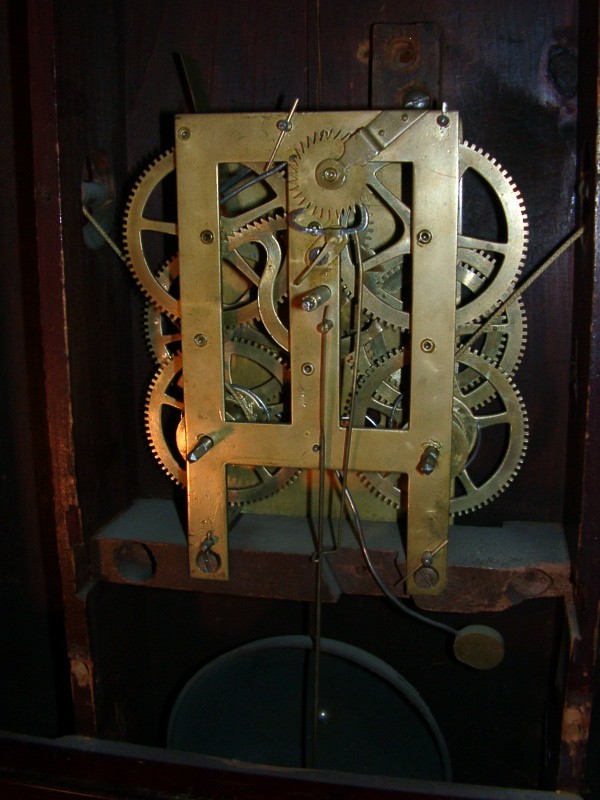 | |||
|
This picture gives a better look at the snail. Tom 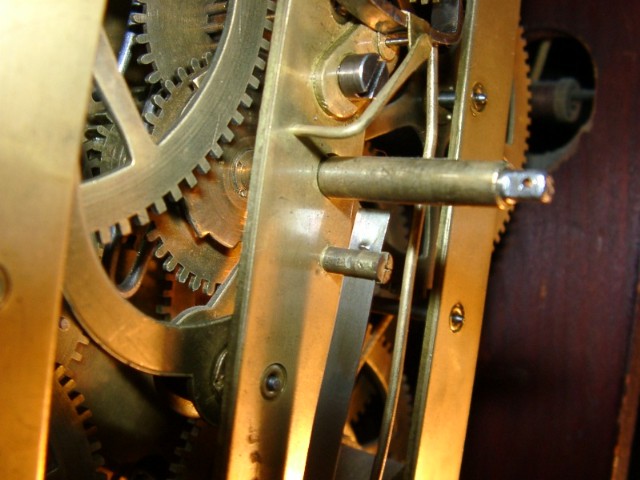 | ||||
|
The repeating feature is even advertised on the glass. Tom 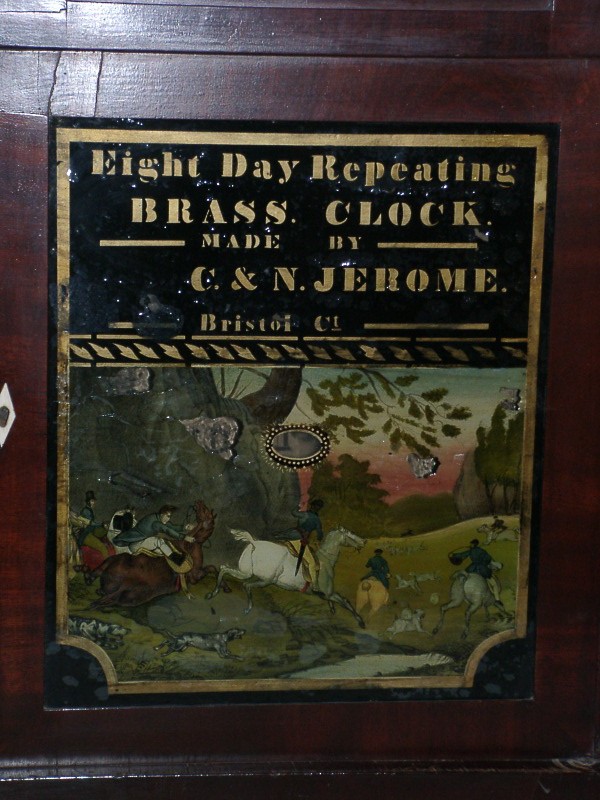 | ||||
|
It is also featured on the label. Tom 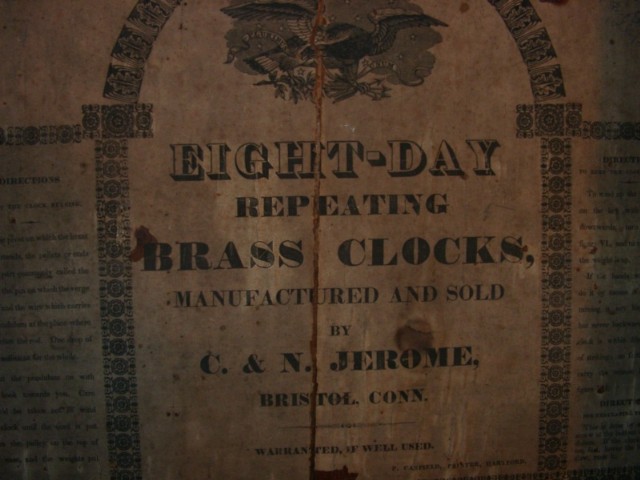 | ||||
|
The whole clock. This general style was typical of wooden movements. I believe C&N Jerome made mainly wood movements. Tom 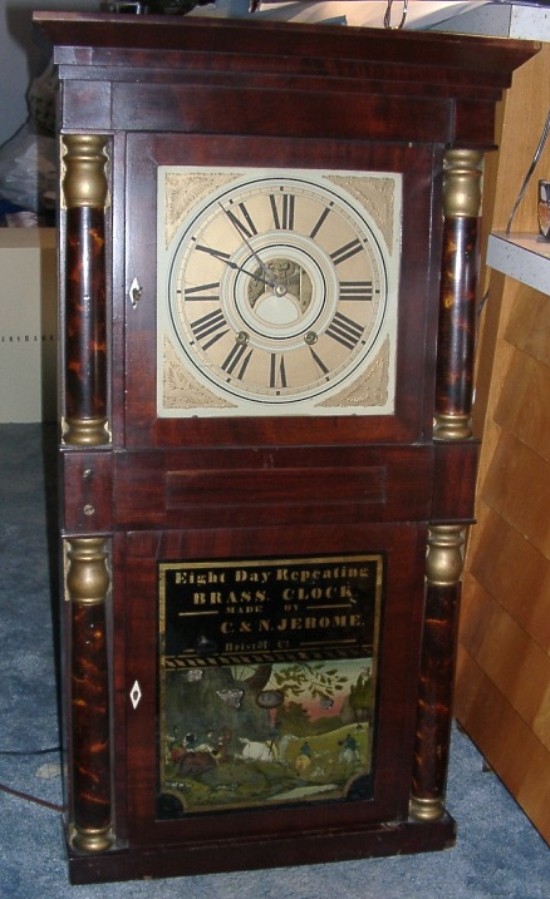 | ||||
|
Interesting clock Tom, have not seen any like that one before. Does the clock work well? Great picture too Tom. | ||||
|
Inside rack movement seems to be a norm with Jerome's clocks...i found one circa 1835.Same set up.its not much Tom but it is all I have found so far. 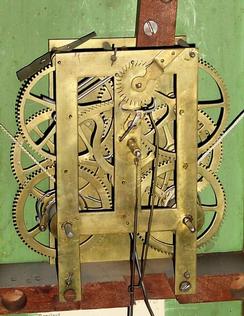 | ||||
|
Stephen, That looks to be the identical movement. It is, however, not really the norm. Jerome and other American made clocks used a countwheel strike system on the vast majority of their clocks. The time period is the same, obviously. I did follow the link. Case styles are similar and it is a C&N Jerome. They were only in business from 1834-1839. The style was not copied by others as far as I know. The movements were made by E.C. Brewster & Co. and bought by C&N Jerome for their clocks. Thanks for the link to a great looking clock! Tom | ||||
|
Tom, What does the "repeating" function mean? Does it stike differently than other clocks? Does it count the hour at the half also? I just saw a regulator on ebay that they call a blind mans clock. It strikes the hour every 15 minutes. Click this link. Not like your's, but does the one you have strike in a similar way? Andy | ||||
|
I will poke my nose in here; many of the 3-weight Austrian and German wall clocks were referred to as 'blind man's clocks' because they strike the quarter and the past hour every quarter. (At 1:00 the clock strikes 4 times on the quarter train and one time on the hour train, at 1:15, the quarter train strikes once and the hour train once, two strikes by the quarter and 1 by the hour at 1:30 and so on until 2:00 when the clock strikes 4 times on the quarter train and twice on the hour train). Many of them have a lever on the right side of the movement back plate that can be pushed and it will allow using the strike trains at will. A couple of the clocks at my house have holes drilled in the door frame and a hole in the lever so that a cord can be tied to the lever and run through the hole to the outside of the case, enabling one to operate the strike at will. I suspect most rack & snail strike movements can be called repeaters in that the strike train can be operated without getting it out of sequence with the hands. I believe another term for the striking in Austrian/German 3-weights is grande sonniere. Some of the pre-1870 versions of these have spring powered striking trains and weight driven time trains. The one I have will run for about 30 hours, the case isn't long enough for an 8-day run. One of the 3-weights hangs by my bed so that I can hear the time at night without being awake for over 15 minutes. | ||||
|
Is there a mechanism on the Jerome to allow the striking to be let off when the dial is attached to the movement and/or the case is closed? | ||||
|
John, So by "repeating", they are only referring to the way you can make it strike the same hour again without getting it out of snyc? My Dad built a grandfather Emperor kit clock, and it had a ball on a cord that you could pull to play the music anytime you wanted. I don't know who made the movement, probably Hermle or Kieninger. Andy | ||||
|
Andy, Yes, that is what I was trying to say. But this was a great advantage before electric lights, think about having to strike a light and fumble around getting a candle or lamp lit in darkness, half asleep, just to see the time. I misspoke in the earlier post, the lever for letting off the strike is on the front plate instead of the back. | ||||
|
Andy and John, There is no mechanism that would make it easy for this clock to "repeat" the strike as you would expect in a clock marked as a repeater, and as found commonly on European clocks as You mention, John. There is a cutout in the dial, but one would have to stick something in and know where to lift to start the strike in motion. If you are that close to the clock you may as well look at the hands to see the time. Of course the "blind man's clock" was mentioned. But if a blind person had to open the upper door and stick a finger through the cutout, they could as easily just feel where the hands are. It appears that it is advertised as a repeating clock because it COULD repeat without getting out of sync with the hands. I think it is a fairly novel movement for American made movements of the time and models itself after the true European repeaters, and maybe they took the name with the design. Anyone with infor more than specualtion is welcome and invited to set the story straight. Thanks Andy and John for your input and questions. Andy, I loved that German clock you had the link to. The square pendulum bob and square weight cases are outstanding!! Tom | ||||
|
It is amazing something so nice is so hard to find information on! Well I will keep looking for you Tom... | ||||
|
Stephen, The information I have comes from Ken Roberts' book The Contribution of Joseph Ives to Connecticut Clock Technology I love the clock you found. That was a great link. Thanks. Tom | ||||
|
I have heard that Chauncey Jerome was a bit of a rascal, so the use of 'repeater' may have been a ploy to increase sales. I suspect he could give the spin doctors and infomercial folks of today a run for their money. | ||||
|
John, One of the most interesting and entertaining biographies I have read is History of the American Clock Business for the past sixty years and Life of Chauncey Jerome written by himself. Chauncey was one of the ones that had to walk through 3 ft. of snow uphill to and from wherever he was going. He has a tough time. His business went under and he had to move from his fine estate to a 3 story brick home next to the church in town. The steeple from the church blew over is a storm and came through the roof of the house. ----Just one of the trials and tribulations of his life. As he says, the history of the American clock business could not have been written without his name being mentioned prominantly. The book is still available. It was a freebie at the 83 Great Lakes Regional. Great Lakes Chapter gave financial support for the book and worked with Chris Bailey at the American Watch and Clock Museum to get the reprint completed. I did find some more info on the movement in Supplement #15, Spring 1986. It seems the design was taken from a German movement. It does, however, seem that Jerome did refine the design. Tom 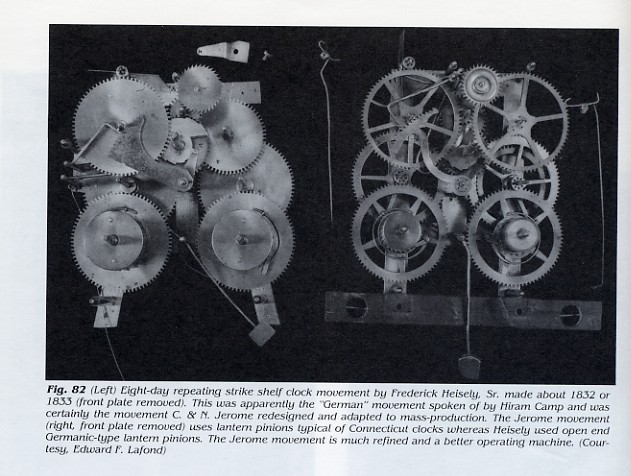 | ||||
|
| Powered by Social Strata |
| Your request is being processed... |
|
©2002-2025 Internet Horology Club 185™ - Lindell V. Riddle President - All Rights Reserved Worldwide

